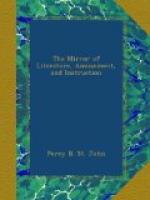In Lapland, their numbers have been compared to a flight of snow when the flakes fall thickest, and the minor evil of being nearly suffocated by smoke is endured to get rid of these little pests. Captain Stedman says, that he and his soldiers were so tormented by gnats in America, that they were obliged to dig holes in the ground with their bayonets, and thrust their heads into them for protection and sleep. Humboldt states, that “between the little harbour of Higuerote and the mouth of the Rio-Unare, the wretched inhabitants are accustomed to stretch themselves on the ground, and pass the night buried in the sand three or four inches deep, exposing only the head, which they cover with a handkerchief.”
After enumerating these and other examples of the achievements of the gnat and musquito tribe, Kirby says, “It is not therefore incredible that Sapor, King of Persia, should have been compelled to raise the siege of Nisibis by a plague of gnats, which attacked his elephants and beasts of burden, and so caused the rout of his army; nor that the inhabitants of various cities should, by an extraordinary multiplication of this plague, have been compelled to desert them; nor that, by their power of doing mischief, like other conquerors who have been the torment of the human race, they should have attained to fame, and have given their name to bays, town, and territories.” Ibid.
Leaf Caterpillars.
The design of the caterpillars in rolling up the leaves is not only to conceal themselves from birds and predatory insects, but also to protect themselves from the cuckoo-flies, which lie in wait in every quarter to deposit their eggs in their bodies, that their progeny may devour them. Their mode of concealment, however, though it appear to be cunningly contrived and skilfully executed, is not always successful, their enemies often discovering their hiding place. We happened to see a remarkable instance of this last summer (1828), in a case of one of the lilac caterpillars which had changed into a chrysalis within the closely folded leaf. A small cuckoo-fly, aware, it should seem, of the very spot where the chrysalis lay within the leaf, was seen boring through it with her ovipositor, and introducing her eggs through the punctures thus made into the body of the dormant insect. We allowed her to lay all her eggs, about six in number, and then put the leaf under an inverted glass. In a few days the eggs of the cuckoo-fly were hatched, the grubs devoured the lilac chrysalis, and finally changed into pupae in a case of yellow silk, and into perfect insects like their parent.—Library of Entertaining Knowledge.
The last extract, and all in the Library of Entertaining Knowledge signed J.R. are written by Mr. J. Rennie, whose initials must be familiar to every reader as attached to some of the most interesting papers in Mr. Loudon’s Magazines. He is a nice observer of Nature, and one of the most popular writers on her phenomena.




